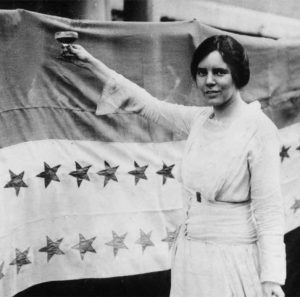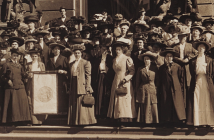On Aug. 18, 1920, American women won the right to vote when the 19th amendment to the U.S. Constitution was ratified.
While the women’s suffrage movement dawned during the first-ever Women’s Rights Convention in Seneca Falls in 1848, support for women’s voting rights increased during the late 19th century. Suffragists understood that the power of the vote is the best way to effect positive change in our country.
Labor unions played a key role as the suffrage movement ramped up around the turn of the 20th century.
As women increasingly entered the workforce, many working women joined labor unions.
The already-decades long struggle for women to have the right to vote was largely reignited through the labor movement and our ongoing right for justice in the workplace. Some labor groups, particularly the Women’s Trade Union League, teamed up with suffragist groups to win justice.
Suffragist leaders not only recruited working women into their ongoing fight to win the right to vote, but adopted some of the same activism tactics commonly used by unions, including demonstrations and political action. Many suffragists faced violence, torture and imprisonment for their cause.
During several 1917 demonstrations, suffragists were arrested for ‘obstructing traffic.’ After refusing to pay a fine, they were taken to a Virginia prison that was infested with rats.

Women’s suffrage leader Alice Paul, shown here
in August 1920, toasts (with grape juice) the
passage of the 19th Amendment that grants all
American women the right to vote.
Two of the jailed suffragists, Alice Paul and Lucy Burns, were among those who led a hunger strike at the prison to show they were willing to give their lives for the right to vote.
Prison officials eventually force-fed the suffragists, shoving a hard tube down their throats to get food into their bodies. The force feedings often led the women to vomit and even nearly suffocate.
Other suffragists were brutally beaten by guards at the same prison, most notably during the Nov. 14, 1917, ‘Night of Terror,’ when nearly 40 guards were ordered to torture the suffragists.
When the public learned about the conditions in the prison, they were angered and the suffragists were eventually released. Soon afterward, President Woodrow Wilson announced his support of the women’s suffrage amendment.
Despite the ratification of the 19th Amendment that gave women the right to vote, many non-Caucasian women could not freely exercise the right to vote for decades due to discrimination, particularly in Southern states where Jim Crow laws were in effect. The Voting Rights Act, signed by President Lyndon B. Johnson in 1965, prohibited discrimination in voting. This law and several subsequent expansions of the law helped address discrimination at the polls, but the fight for voting rights is still a struggle for many Americans.
Nearly a century after the 19th Amendment was ratified, it is crucial we remember the suffragists’ fight and use our right to vote.


